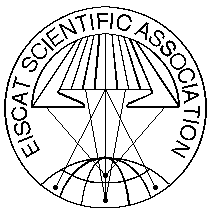
November 28 - December 02, 2011 - Namur, Belgium
Posters session 3B
Space Climate
| Session: | Posters Session 3B (11) |
| Type: | |
| Date: | Wednesday, November 30, 2011 |
| Time: | 10:30 - 11:15 |
| Chair: | Ilaria Ermolli & Kalevi Mursula |
| Co-chair: | |
| Remarks: |
| Seq | Time | Title | Abs No | ||||
| 1 | 00:00 |
Actual Theoretical and Observational Predictability Limits in Solar-Terrestrial Physics
Veselovsky, Igor Institute of Nuclear Physics, RUSSIAN FEDERATION The analysis of available data indicates that the probability of abnormal and unusual situations is low, but not negligible. Solar and heliospheric dynamics is only partially predictable because of several main causes: 1) not sufficient knowledge of all needed input parameters of boundary and initial conditions for the existing models. For example, electric fields are not measured on the Sun; 2) inaccuracy of model approximations and unstable behavior of the energetically open physical systems under consideration. Big amount of degrees of freedom and energy fluxes are resulting in the self-organization processes which are sensitive to small perturbations and nonlinear bifurcations; 3) multi-scale situations are often not tractable when using actual models and computational capabilities. Dynamical description from the first principles of MHD and kinetic equations is limited in applications and has no practical sense beyond horizons in space and time, which are not well investigated, but can be only empirically guessed and determined a posteriori from observations. Statistical approaches and expert evaluations are also limited by the accumulated level of previous knowledge. It is especially true for the rare situations of extremely strong perturbations and unusually quiet periods, which are sometimes documented, but remain unique, not common and practically unpredictable with a sufficient reliability. We investigate several examples of actual predictability horizons using different predictors for the appearance of new active regions and sunspots on the Sun, for the high speed solar wind streams from coronal holes and for solar proton events after flares. Asymptotic values of possible uppermost and lowest (not observed as yet) amplitudes of geomagnetic perturbations expressed by different indices also exist because of the permanent solar activity, which is limited from both sides. It can be not higher than the available free energy reservoir of the magnetic fields in the corona and less than some noise level of thermal fluctuations on the Sun. More investigations of rare and unexpected situations are needed in future. |
|||||
| 2 | 00:00 |
Thunderstorm Ground Enhancements (TGEs) Evidence of the huge natural Accelerators in the Thunderclouds
Chilingarian, Ashot Yerevan Physics Institute, ARMENIA Strong electrical fields inside thunderclouds give rise to fluxes of high energy electrons and, consequently, gamma rays and neutrons. Gamma rays and electrons are currently detected by the facilities of low orbiting satellites and by networks of surface particle detectors. During intensive particle fluxes, coinciding with thunderstorms, series of particle bursts were detected by the particle detectors of Aragats Space Environmental Center (ASEC) on altitude of 3200 m. We classify the thunderstorm ground enhancements (TGEs) in 2 categories, one lasting microseconds, the other lasting up to tens of minutes. Both types of events can occur at the same time, coinciding with large negative electric field between cloud and ground and negative intracloud lightning occurrence. Statistical analysis of the short TGE bursts sample suggests the duration is less than 50 µs and spatial extension is larger than 1000 m2. Huge enhancements of the particle fluxes (up to 600%) and short extended burst of particle showers point on relativistic runaway electron avalanches (RREA) process in the thunderclouds. The smaller peaks in the secondary cosmic ray fluxes (1-20% enhancements) can be explained without evoking particle multiplication in the avalanche process. We discuss the origin of TGEs and its connection to the terrestrial gamma flashes (TGF), detected by orbiting gamma-ray observatories. Simultaneously detected energy spectra of electrons and gamma rays recovered from largest TGE events detected at Aragats will be presented and discussed as well. Energy spectra are based on large statistics and prolonged up to 100 MeV. Detection of neutrons during TGE events also will be presented and discussed. |
|||||
| 3 | 00:00 |
Space Weather - Climate Relations: A Different Approach.
Stauning, Peter Danish Meteorological Institute, DENMARK Based on data from 1850 to 1985, regression analysis between solar activity represented by the cycle-average sunspot number, SSNA, and global temperature anomalies, DTA , averaged over the same interval lengths, but delayed by 3 years, provides the relation DTA = 0.009 (±.002) SSNA . Since the largest ever observed SSNA is ~90 (in 1954-1965) and the smallest possible is ~0, the solar activity-related changes in global temperatures could amounts to no more than ±0.4°C from the mean over the past ~400 years where the sunspots have been recorded. It is demonstrated that the small amplitudes of cyclic variations in the average global temperatures over the ~11 year solar cycle excludes many of the various Space Weather driver processes suggested in published and frequently quoted solar activity-climate relations. It is held that the in-cycle variations and also the longer term variations in global temperatures over the examined 135 years are mainly caused by corresponding changes in the total solar irradiance level representing the energy output from the core, but further modulated by varying energy transmission properties in the active outer regions of the Sun. The analysis of recent data has shown clearly that the temperature development since ~1985 is controlled by additional forcing beyond solar activity. |
|||||
| 4 | 00:00 |
On Possibility Of Space Weather Influence On Earth Crops: The Necessary Conditions And Possible Scenarios
Pustil'nik, Lev1; Yom Din, Gregory2 1Israel Space Weather and Cosmic Ray Center, ISRAEL; 2Golan Research Institute, Haifa University, ISRAEL
Remarkable progress in understanding of solar-terrestrial connections was had place during last twenty years. Partly, influence of space weather (solar wind, magnetosphere activity, flux of cosmic ray of high energy) on local Earth weather was discovered. The results revived interest to potential sequences of this influence on agriculture and on prices of agriculture production (during last 300 years this possibility considered by Jonathan Swift, William Herschel, William Jevons, and Alexander Chizhevsky). |
|||||
| 5 | 00:00 |
Survey and Merging of Sunspot Catalogs: accessing the smallest Sunspots Details
Lefevre, Laure; Clette, Frederic ROB, BELGIUM In this study, we explore how detailed information down to the level of individual sunspots can be used to improve our understanding of the solar cycle. For this purpose, we can use existing multi-decade sunspot catalogs. However, the latter have multiple limitations in time coverage, recorded parameters and homogeneity. In a first approach, we use the Debrecen Photoheliographic Data (DPD), based on a few ground-based observatories and SOHO data, and the US Air Force/Mount Wilson catalog built by the Improved Solar Optical Observing Network (ISOON). Using those data sets, we can illustrate how the information from parallel catalogs can be merged to form a much more comprehensive record of sunspot groups. After filtering out invalid features, we find a 96.5% match between the DPD and USAF sunspot group entries. Currently nearing completion, this merging work will lead to the most comprehensive sunspot group catalog for the 1986 - 2011 period. Here we show how this very detailed information can be used: it enables us to access to the evolution of collective parameters of sunspot groups down to the evolution of the smallest spots. We can evaluate the importance of each sunspot group parameter for the reconstruction of fundamental reference indices (Ri, F10.7,MgII) relevant to the coupling between the chromospheric UV irradiance and the Earth's ionosphere. Moreover, because of the important level of details reached here, sunspot-based proxies will provide much better reconstructions of solar emissions now and in the past, and thus help predict future trends in the solar cycle. |
|||||
| 6 | 00:00 |
The Southern and Northern Hemisphere Auroral Ovals are rarely sleeping
Tanskanen, E.I.1; Grönroos, S.-A.2; Gjerloev, J.W.3; Van de Kamp, M.1; Viljanen, A.1; Mursula, K.4; Stolle, C.5 1Finnish Meteorological Institute, FINLAND; 2Aalto University, FINLAND; 3University of Bergen, Department of Physics and Technology, NORWAY; 4Oulu University, FINLAND; 5DTU Space, DENMARK The northern hemisphere geomagnetic activity has been widely examined based on different geomagnetic activity indices. In this paper, we identify individual substorms by an algorithmical search engine method for both southern and northern hemispheres. The northern hemisphere substorms are identified since 1993 for the entire solar cycle 23 and for the part of the solar cycles 22 and 24. The southern hemisphere substorms are identified for all phases of the solar cycle 23. Magnetic field measurements e.g. from IMAGE and Greenland networks are used in the analysis in addition of the westward electrojet index from the SuperMAG initiative (SML). Examples of isolated and cyclic substorms during both non-storm and stormy conditions will be shown. In case-by-case basis there were differences between southern and northern hemisphere substorm activity, but statistically both hemispheres seem to behave quite similarly. We found a clear tendency of getting more frequent and stronger substorms during the declining solar cycle phases compared to maximum, minima and ascending phases. However, auroral ovals were surprisingly active also during the extended solar minimum between the solar cycles 23 and 24 indicating that the auroral ovals are rarely, if ever, sleeping over long times. We will furthermore show results of the conjugate pulsation analysis and discuss about the seasonal variation in substorm activity for both hemispheres. |
|||||
| 7 | 00:00 |
Corrected NOAA/MEPED energetic particle Fluxes and their Connection to Solar Wind Parameters
Asikainen, Timo; Mursula, Kalevi; Maliniemi, Ville University of Oulu, FINLAND The NOAA/POES satellites have measured energetic particles with their MEPED instrument nearly continuously for more than 30 years. Up to now the reliable usage of the data has been severely restricted by several instrumental problems including degradation due to radiation damage, detector noise and contamination of electron measurements by protons. Radiation damage affects the proton detectors of all the satellites and leads to significantly erroneous fluxes already a few years after satellite launch. Detector noise affects the proton detectors as well but is fortunately a problem in only two NOAA satellites. Electron contamination by protons is a well known problem but its correction requires accurate knowledge of the proton fluxes. We have extensively studied these issues in the data and have now for the first time produced a new NOAA/MEPED database that corrects the data for all the above mentioned problems. Here we briefly review the problems that have plagued the NOAA/MEPED database and present the methods we used to address them. As a first application of the corrected data we study the connection between the daily averaged energetic particle fluxes and solar wind parameters. We develop a simple linear filter model to describe the relation between the fluxes and show that the most dominant factor controlling energetic particle precipitation is the solar wind speed. |
|||||
| 8 | 00:00 |
CR and other Space Climate Factors influenced on the Earth's Climate Change
Dorman, Lev Israel Cosmic Ray and Space Weather Center (Tel Aviv University and Israel Space Agency), ISRAEL It is obviously now that according to data for the past on big variations of planetary surface temperature in scales of many millions and thousands years the Earth's global climate change is determined mostly by space factors: moving of the Solar system around the center of our Galaxy with crossing galactic arms and dust-molecular clouds, nearby supernova and supernova remnants. Important space factor is also the cyclic variations of solar activity and solar wind (mostly in scales of hundreds years and decades). The action of space factors on the Earth's climate is realized mostly through cosmic rays (CR) and space dust influenced on formation of clouds controlled the total energy input from the Sun into the Earthís atmosphere. The propagation and modulation of galactic CR (generated mostly during Supernova explosions and in Supernova remnants in our Galaxy), in the Heliosphere are determined by their interactions with magnetic fields frozen in solar wind and in coronal mass ejections (CME) with accompanied interplanetary shock waves (produced big magnetic storms during their interactions with the Earth's magnetosphere). The most difficult problem of monitoring and forecasting the modulation of galactic CR in the Heliosphere is that the CR intensity in some 4D space-time point is determined not by the level of solar activity at this time of observations and electro-magnetic conditions in this 4D-point but by electromagnetic conditions in total Heliosphere. These conditions in total Heliosphere are determined by development of solar activity during many months before the time-point of observations. It is main cause of so called hysteresis phenomenon in connection galactic CR - solar activity. From other hand, detail investigations of this phenomenon give important possibility to estimate conditions in and dimension of Heliosphere. To solve described above problem of CR modulation in the Heliosphere, we considered as the first step behavior of high energy particles (more than several GeV, for which the diffusion time of propagation in Heliosphere is very small in comparison with characteristic time of modulation) on the basis of neutron monitor data in the frame of convection diffusion theory, and then take into account drift effects. For small energy galactic CR detected on satellites and space probes we need to take into account also additional time lag caused by diffusion in the Heliosphere. Then we consider the problem of CR modulation forecasting for several months and years ahead, what gives possibility to forecast some part of global climate change caused by CR. This work is prepared in the frame of COST 803 program and supported by foundation "INFRASTRUCTURE" of Israel Ministry of Science and will be submitted to the Journal Space Weather and Space Climate. |
|||||
| 9 | 00:00 |
The wide skirt of the bashful ballerina: Hemispheric asymmetry of the HMF in the inner and outer heliosphere
Mursula, Kalevi; Virtanen, Ilpo University of Oulu, FINLAND We reanalyze the observations of the heliospheric magnetic field (HMF) made by the Pioneer 10 and 11 and Voyager 1 and 2 heliospheric probes since 1972, and calculate the HMF sector occurrence ratios and tangential component strengths in the different regions of the heliosphere. Observations at the distant probes and at 1 AU show a very consistent picture of the HMF sector structure in the entire heliosphere, and even beyond the termination shock. Pioneer 11 and Voyager 1 show that the development of northern polar coronal holes was very systematic and active during all the four solar minima since mid-1970s. On the other hand, Voyager 2 observations show a less systematic and delayed development of southern coronal holes in 1980s, 1990s and 2000s. This delay in the evolution of southern coronal holes with respect to the rapid and systematic evolution of northern coronal holes leads to a larger extent of northern coronal holes and a southward shift of the heliospheric current sheet (the bashful ballerina phenomenon) for a few years in the late declining phase of each solar cycle. HMF observations of the probes also directly verify the HCS southward shift, supporting earlier observations at 1-2 AU by the Ulysses probe and Earth-orbiting satellites and extending them into the more distant heliosphere. Although the evidence for the connection between the temporal difference in the evolution of polar coronal holes and the bashful ballerina times is based only on three solar cycles, this may be a common pattern for solar coronal hole evolution since the southward shift of the HCS has occurred at least since solar cycle 16. |
|||||
| 10 | 00:00 |
Total Solar Irradiance in Cycle 23:
Modelling of measured Variations by synoptic intensity Observations
Criscuoli, Serena; Ermolli, Ilaria; Giorgi, Fabrizio INAF Osservatorio Astronomico di Roma, ITALY An apparently unusual behaviour of the Total Solar Irradiance (TSI) during the last solar minimum, together with unexpected trends of the spectral irradiance variations measured over the declining phase of the last solar cycle, and the registered failure of some irradiance models to reproduce TSI measurements have been interpreted as new evidences of a fraction of the measured solar irradiance variability unexplained by the evolution of surface magnetism. On the other hand, newest results put the responability of these inconsistencies to calibration problems of both total and spectral irradiance measurements. We test claims that the evolution of the solar surface features does not reproduce the measured TSI in cycle 23. We use the synoptic full-disk observations carried out with the PSPT telescopes and results of the spectral synthesis performed on semi-empirical reference atmosphere models to model measurements of TSI variations from 1997 to 2011. We also investigate the contribution to the measured variations of the various solar features resolved on PSPT observations. |
|||||











